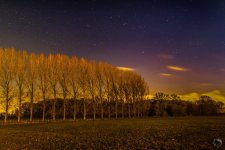You are using an out of date browser. It may not display this or other websites correctly.
You should upgrade or use an alternative browser.
You should upgrade or use an alternative browser.
Post your low light long exposures
- Thread starter Lee532
- Start date
I tested the information I read about ISO being a post-sensor process. It implies that no matter what the ISO setting, the sensor does not count more or less photons. That means that unless there is clipping, I should be able to grab as many stars using ISO 100 as I do at ISO 6400. All that ISO does is increase noise and saturated pixels.
I shot the 100 through 6400 range at 20 min and then processed those solely to check the differences in the sky. The higher the ISO, the more issues I had with the present pollution.
Here's the series:
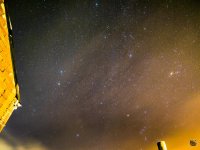
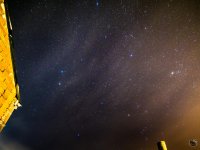
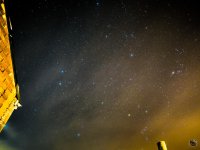
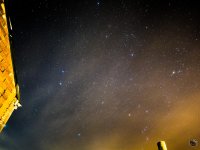
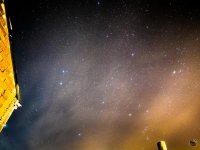


Even when some stars are brighter at higher ISO, that as easily can be accomplished by blending the same shot. All that ISO seems to add (for my cam) is noise and haze.
The best for my cam is to open up as wide as possible and shoot the longest shutter possible at ISO 100. The rest is best done in post since there the noise is not multiplied.
I shot the 100 through 6400 range at 20 min and then processed those solely to check the differences in the sky. The higher the ISO, the more issues I had with the present pollution.
Here's the series:







Even when some stars are brighter at higher ISO, that as easily can be accomplished by blending the same shot. All that ISO seems to add (for my cam) is noise and haze.
The best for my cam is to open up as wide as possible and shoot the longest shutter possible at ISO 100. The rest is best done in post since there the noise is not multiplied.
Last edited:
Interesting point. I do not think I would have come to that same conclusion without your post but it now makes sense to me. maybe you should do a low-light tutorial. Although, in a sense, you already are.
I'm not the type to do tutorials.
I think it depends on the cam and the sensitivity of the sensor but for mine stars don't require high ISO. A different sensor might not do as well at ISO 100.
When it clips might be another matter. I didn't find information yet how the cam defines brightness levels but that seems to be definitive in a RAW file. Once information is clipped, it is lost forever so something is making decisions which strength of signal will be neglected and stored as 0 and which fully saturates the pixel and is stored as 255 and ISO influences that decision. It's also a post-sensor process but apparently one I can't get around in post.
ISO only influences how the photons are counted so I don't really understand why we can't change that afterwards. The cam knows the count and the method of counting. If the cam stores the values of every pixel, in theory, when shooting manual, you should be able to over or underexpose in post even if clipping occurs since ISO does not affect the incoming signal in manual mode.
Maybe bit size is the limiter here, I don't know.
Last edited:
I tested the information I read about ISO being a post-sensor process. It implies that no matter what the ISO setting, the sensor does not count more or less photons. That means that unless there is clipping, I should be able to grab as many stars using ISO 100 as I do at ISO 6400. All that ISO does is increase noise and saturated pixels.
I shot the 100 through 6400 range at 20 min and then processed those solely to check the differences in the sky. The higher the ISO, the more issues I had with the present pollution.
Here's the series:
Even when some stars are brighter at higher ISO, that as easily can be accomplished by blending the same shot. All that ISO seems to add (for my cam) is noise and haze.
The best for my cam is to open up as wide as possible and shoot the longest shutter possible at ISO 100. The rest is best done in post since there the noise is not multiplied.
This seems strange. How come the fence on the left is not getting any brighter as the ISO is increasing ? Is that because it was so dark that even at iso6400 there was still no clipping ?
This seems strange. How come the fence on the left is not getting any brighter as the ISO is increasing ? Is that because it was so dark that even at iso6400 there was still no clipping ?
Original 100 + 6400:
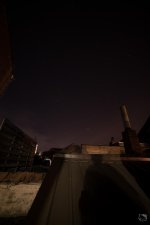
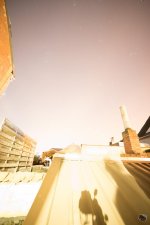
There's only six stops difference between both. This is a typical lighting situation I'm in when shooting at night. It's even pretty bright since I'm in town. I've always been shooting high ISO to get the stars out and that's the general idea many follow and that can be read everywhere online but we never pause and think; would that still be the case?
Technology changes fast and what used to be impossible yesterday might be quite possible today. Once I realized ISO was a post-process, I could not but realize I get the same signal whatever the ISO I use (in manual).
Last edited:
I have to test this during the daytime too since it can have more effect than I imagined.
Take as an example when I'm birding. I'm shooting at ISO100 at f/6.3 and my shutter is maxed at 1/500s for correct exposure. What I usually do is increase the ISO, let's say 200 in this case and use that to get a faster shutter of 1/1000s and my exposure remains identical.
But this is not really the case. The exposure of my end-result will be largely identical but the sensor only received half the signal because the shutter duration is halved using the same diaphragm. What the cam does is count the sensors pixel saturation and what was 1 before, now is 2. It does so too with noise and although it is less of a problem during daytime, signal noise is ever present. The accuracy of a signal measured is proportional to the size of that signal captured. For photon counting, noise seems to be the square root of the amount captured.
Which means 9 photons results into 3 noise (SNR of 3) while 100 photons in 10 noise (SNR of 10). Both increase but not at the same rate. The problem with using ISO is the decrease of the signal size which inevitable leads to an increase in noise (in terms of SNR), which then also gets amplified.
Now for many shots we don't have a choice. Either a shutter or aperture (or both) are required and ISO is the only option left but when not, ISO should always be last on the list. I can better underexpose as long as I can recover that in post, than up the ISO and do actually the same underexposure but with additional noise when that gets normalized.
But again, it depends on the cam's sensor efficiency how far we can take this, and on the circumstances we are shooting.
Take as an example when I'm birding. I'm shooting at ISO100 at f/6.3 and my shutter is maxed at 1/500s for correct exposure. What I usually do is increase the ISO, let's say 200 in this case and use that to get a faster shutter of 1/1000s and my exposure remains identical.
But this is not really the case. The exposure of my end-result will be largely identical but the sensor only received half the signal because the shutter duration is halved using the same diaphragm. What the cam does is count the sensors pixel saturation and what was 1 before, now is 2. It does so too with noise and although it is less of a problem during daytime, signal noise is ever present. The accuracy of a signal measured is proportional to the size of that signal captured. For photon counting, noise seems to be the square root of the amount captured.
Which means 9 photons results into 3 noise (SNR of 3) while 100 photons in 10 noise (SNR of 10). Both increase but not at the same rate. The problem with using ISO is the decrease of the signal size which inevitable leads to an increase in noise (in terms of SNR), which then also gets amplified.
Now for many shots we don't have a choice. Either a shutter or aperture (or both) are required and ISO is the only option left but when not, ISO should always be last on the list. I can better underexpose as long as I can recover that in post, than up the ISO and do actually the same underexposure but with additional noise when that gets normalized.
But again, it depends on the cam's sensor efficiency how far we can take this, and on the circumstances we are shooting.
Last edited:
So the six shots you posted have all been adjusted in post to give the same effective exposure - that now makes more sense. The two you show above are very different as I would have expected.
I did it to check how many more stars my ISO increase would grab but in reality, the sensor grabbed exactly the same light during all ISO settings. When I normalize all so the skies are about equally processed (taking care to not hide stars), they show about the same amount.
The only thing I increased with the ISO was my problems afterwards.
I never gave it much thought since you're used to the film's ISO being an indication of sensitivity to light and that maybe got too easily adopted to explain the ISO function of digital cams but somewhere on the road, many dropped "the equivalent of" and it became the ISO defines the sensitivity of the sensor. I was under the impression it actually changed the sensitivity.
If you're in an ISO situation, give it a try and see what the cam + post can do and which of both works best or delivers the best quality. What the D750's sensor does not necessarily is the same for all. The technical part however works similar.
Last edited:
Scott Murray
Senior Member
[MENTION=31330]J-see[/MENTION] I am guessing you have not tried 'dark sky' photography? As if you did it would require more ISO. But I admit that for places where you get a lot of light pollution the lower ISO is better.
Scott Murray
Senior Member
This one here was taken at ISO 4000, and I doubt ISO 100 would have achieved the same with the little moonlight I had.

Lost City under moonlight by Scott H Murray, on Flickr

Lost City under moonlight by Scott H Murray, on Flickr
Scott Murray
Senior Member
Scott Murray
Senior Member
No moonlight and 3200 ISO.

Lost City Litchfield National Park under the Milky way. by Scott H Murray, on Flickr

Lost City Litchfield National Park under the Milky way. by Scott H Murray, on Flickr
@J-see I am guessing you have not tried 'dark sky' photography? As if you did it would require more ISO. But I admit that for places where you get a lot of light pollution the lower ISO is better.
I'm living in the Christmas tree of Europe when it comes to night lights so it is very hard for me to find an area where there is truly a dark sky. I know of one area that is less polluted but I need to have the time to get there and the right conditions which isn't that often.
But if I get the chance, I'll go there and give it a try but in theory I don't see how it would make much of a difference. ISO doesn't affect the light that hits the sensor nor how the sensor "counts" it so whatever ISO increases post sensor, should be in my shot no matter what ISO I used.
Unless it is clipped during the conversion to digital.
Scott Murray
Senior Member
Really? Well you better start telling the camera companies as they seem to think it does effect the light input. But what do they know?I'm living in the Christmas tree of Europe when it comes to night lights so it is very hard for me to find an area where there is truly a dark sky. I know of one area that is less polluted but I need to have the time to get there and the right conditions which isn't that often.
But if I get the chance, I'll go there and give it a try but in theory I don't see how it would make much of a difference. ISO doesn't affect the light that hits the sensor nor how the sensor "counts" it so whatever ISO increases post sensor, should be in my shot no matter what ISO I used.
Unless it is clipped during the conversion to digital.
Really? Well you better start telling the camera companies as they seem to think it does effect the light input. But what do they know?
I don't know about yours but my cam has no sensor that can be adjusted in sensitivity. It has a certain quantum efficiency and that's it. The ISO defines how the voltage meter reads the sensor pixels, not how the sensor pixels read the light.
Scott Murray
Senior Member
Might answer your dilema - How is ISO implemented in digital cameras? - Photography Stack ExchangeI don't know about yours but my cam has no sensor that can be adjusted in sensitivity. It has a certain quantum efficiency and that's it. The ISO defines how the voltage meter reads the sensor pixels, not how the sensor pixels read the light.
You don't need to believe me and if you prefer shooting at 6400 more power to you but in case you want to know what actually happens, this site is rather interesting.
www.Clarkvision.com: ISO and Digital Cameras, ISO Myths
I tested it and it seems to be correct, at least for those shots during those conditions. Before I always shot high ISO for stars but now I tried both, low does a better job for me.
www.Clarkvision.com: ISO and Digital Cameras, ISO Myths
I tested it and it seems to be correct, at least for those shots during those conditions. Before I always shot high ISO for stars but now I tried both, low does a better job for me.
RockyNH_RIP
Senior Member
No moonlight and 3200 ISO.

Lost City Litchfield National Park under the Milky way. by Scott H Murray, on Flickr
Scott, I like this series... I have been wanting to try something like this but too many lights out front and out back is an Motion triggered light. I could set up and trigger by remote AFTER the light goes back off... I need to time that. I like the light but it is a nuisance for shooting where there is no switch.
We need an electrician in for some other work and when we do, I am gonna see if he can put that on a switch.
Pat in GA
Scott Murray
Senior Member
Cheers Pat, these were taken away from city lights so no light pollution that I didn't want. I am lucky now that I can be out of a light polluted area within 10mins seeing as I live in a National Park. Will be plenty more of these so long as I keep away from the crocodiles.Scott, I like this series... I have been wanting to try something like this but too many lights out front and out back is an Motion triggered light. I could set up and trigger by remote AFTER the light goes back off... I need to time that. I like the light but it is a nuisance for shooting where there is no switch.
We need an electrician in for some other work and when we do, I am gonna see if he can put that on a switch.
Pat in GA

